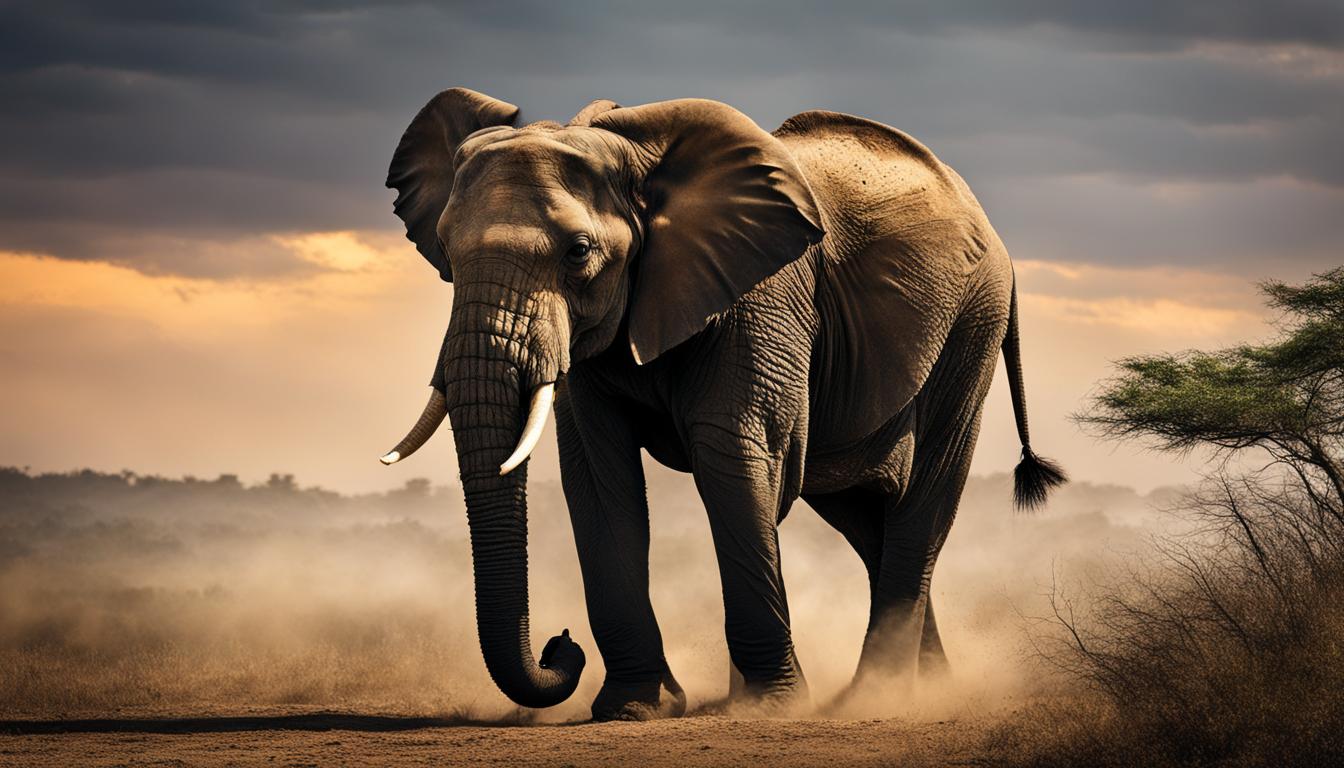Are you curious about the weight and size of elephants? In this article, we will explore fascinating facts about the average weight of elephants and their impressive size.
Imagine standing next to a massive elephant that weighs up to 15,000 pounds (6,800 kilograms) – that’s as heavy as a small truck! African elephants, the largest species, can weigh nearly 200 pounds at birth. These gentle giants can also reach heights of up to 13 feet (4 meters) at the shoulder. Can you picture being next to such a majestic creature?
On the other end of the spectrum, the Borneo elephant is the smallest species, standing at less than 5 feet (1.5 meters) high and weighing up to 4,000 pounds (1,800 kilograms). Even the smallest elephants still capture our hearts with their unique charm.
Now that you have a glimpse into the weight and size of elephants, let’s delve deeper into their origins and other intriguing facts. Continue reading to satisfy your curiosity about these magnificent creatures.
Where do elephants come from?
Elephants have a fascinating origin that can be traced back millions of years. These magnificent creatures originated in Africa and Asia, where they are found in the wild to this day. The earliest fossil remains of elephants date back approximately 4 million years, providing evidence of their ancient existence. Today, African elephants and Asian elephants are the two main species that we are familiar with.
The African Elephants
African elephants are native to the African continent, particularly sub-Saharan Africa. They are the largest land animals on Earth and can be further classified into two subspecies: the African forest elephant and the African savanna elephant. These majestic creatures are known for their impressive size, intelligence, and strong social bonds.
The Asian Elephants
Asian elephants, on the other hand, are primarily found in various parts of Asia, including India, Sri Lanka, Thailand, and Indonesia. They are slightly smaller in size compared to their African counterparts but are still among the largest land mammals. Asian elephants have distinct physical features, such as smaller ears and rounded backs, which set them apart from African elephants.
Overall, elephants have a rich history and play a vital role in shaping the ecosystems they inhabit. Their unique origins and diverse habitats make them truly remarkable animals deserving of our admiration and protection.
| Elephant Species | Origin |
|---|---|
| African Elephant | Sub-Saharan Africa |
| Asian Elephant | Various parts of Asia |
The Weight and Size of Elephants
When it comes to the weight and size of elephants, these magnificent creatures are nothing short of impressive. On average, African elephants weigh about 12,000 pounds (5,443 kilograms), making them the largest land animals on Earth. However, male elephants can be significantly larger than females, with weights ranging between 5,000 and 14,000 pounds. Female elephants typically weigh between 6,000 and 8,000 pounds. In comparison, Asian elephants are smaller, weighing between 4,400 and 11,000 pounds.
The sheer size of elephants is a testament to their strength and resilience. Males, in particular, can reach staggering heights, standing up to 13 feet (4 meters) tall at the shoulder. This towering stature gives them a commanding presence in their natural habitat, making them truly awe-inspiring creatures. Females, although slightly smaller, still possess an impressive size and strength that should not be underestimated.
To visualize the weight and size differences of elephants more effectively, refer to the table below:
| Elephant | Average Weight (pounds) | Average Height at Shoulder (feet) |
|---|---|---|
| African Elephant (male) | 5,000 – 14,000 | 13 |
| African Elephant (female) | 6,000 – 8,000 | 12 |
| Asian Elephant | 4,400 – 11,000 | 9 |
As you can see, there are significant differences in the weight and height of elephants depending on their species and gender. African elephants, both male and female, tend to be larger than their Asian counterparts. These variations in size play a crucial role in the ecology and behavior of these magnificent creatures, shaping their interactions with their environment and other species.
Size Comparison of Elephant Subspecies
When it comes to elephant size, there are notable differences between the various subspecies. African and Asian elephants, in particular, showcase distinct variations in height and weight.
Starting with the African elephant, this magnificent species can grow to be over 13 feet (4 meters) tall at the shoulder. They are the largest land animals, with males weighing up to an impressive 15,000 pounds (6,800 kilograms). Female African elephants, on the other hand, typically weigh between 6,000 and 8,000 pounds (2,700 to 3,600 kilograms). These elephants have a bulkier build compared to their Asian counterparts.
Asian elephants, although smaller in size, still command attention with their stature. They have a shoulder height ranging from 6.6 to 11.5 feet (2 to 3.5 meters). In terms of weight, Asian elephants weigh between 4,400 and 11,000 pounds (2,000 to 5,000 kilograms). While they may not reach the colossal proportions of African elephants, they are still impressive creatures in their own right.
| Elephant Subspecies | Average Height (at shoulder) | Average Weight |
|---|---|---|
| African Elephant | Over 13 feet (4 meters) | Males: Up to 15,000 pounds (6,800 kilograms) Females: 6,000 to 8,000 pounds (2,700 to 3,600 kilograms) |
| Asian Elephant | 6.6 to 11.5 feet (2 to 3.5 meters) | 4,400 to 11,000 pounds (2,000 to 5,000 kilograms) |
These size differences highlight the diversity within the elephant family. While the African elephant astounds with its imposing frame, the Asian elephant possesses its own grace and charm. Both subspecies command respect and admiration for their incredible size and strength.
Size Comparison of Elephant Subspecies
In a nutshell:
- African elephants are the largest land animals, with males weighing up to 15,000 pounds (6,800 kilograms).
- Female African elephants typically weigh between 6,000 and 8,000 pounds (2,700 to 3,600 kilograms).
- African elephants can grow to be over 13 feet (4 meters) tall at the shoulder.
- Asian elephants have a shoulder height ranging from 6.6 to 11.5 feet (2 to 3.5 meters).
- Asian elephants weigh between 4,400 and 11,000 pounds (2,000 to 5,000 kilograms).
Whether African or Asian, these majestic creatures captivate us with their sheer size and presence.
Interesting Facts About Elephant Weight
When it comes to weight, elephants are truly remarkable creatures. They have the ability to consume massive amounts of food in a single day. African elephants, for example, can eat as much as 330 pounds (150 kilograms) of food daily. This equates to a daily food intake that is about 4-7% of their body weight. In fact, the largest elephants can consume over 300 pounds of food in just one day.
But why do elephants need to eat so much? The answer lies in their sheer size. These magnificent animals are the largest land animals on the planet. Male African elephants can weigh up to a staggering 15,000 pounds (6,800 kilograms). To sustain their massive bodies, they need to consume substantial amounts of food.
“African elephants can eat as much as 330 pounds (150 kilograms) of food in a day.”
It’s not just their weight that sets elephants apart, but also their unique eating habits. They are herbivores, meaning they only eat plant-based foods. This includes various types of grasses, leaves, bark, and even branches. With their powerful jaws and versatile trunks, elephants can effortlessly strip leaves off branches and pluck grass from the ground.
| Fact | Weight |
|---|---|
| African Elephant Daily Food Intake | 330 pounds (150 kilograms) |
| Largest Elephants’ Daily Food Intake | Over 300 pounds |
| Largest Male African Elephant | 15,000 pounds (6,800 kilograms) |
| Largest Female African Elephant | 8,000 pounds (3,600 kilograms) |
All this food consumption not only fuels their massive bodies but also helps them maintain their energy levels for their daily activities. Elephants are known for their social behaviors and their ability to travel long distances in search of food and water.
So, the next time you come across an elephant, take a moment to appreciate their incredible size and the extraordinary amount of food they consume every day. They truly are marvels of nature.
Why do elephants have such large ears?
Elephants have some of the largest ears of any land animal, and there is a fascinating reason behind this unique feature. The primary purpose of their large ears is to help regulate their body temperature. Unlike humans and many other animals, elephants do not have sweat glands. As a result, they cannot rely on evaporation to cool down their bodies. Instead, they have developed a clever cooling mechanism using their ears.
Elephants have a network of blood vessels running through their ears, which are close to the skin’s surface. When they feel hot, they flap their ears vigorously, creating a breeze that passes over the blood vessels and cools the blood circulating within them. This cooled blood then circulates throughout the elephant’s body, helping to lower its overall temperature. It’s a remarkable adaptation that allows elephants to stay comfortable in hot climates.
“Elephants have a clever cooling mechanism using their ears.”
The large surface area of the ears also plays a role in enhancing this cooling effect. The size of an elephant’s ears allows for maximum exposure to the air, maximizing the heat exchange that occurs when the blood vessels come into contact with the outside air. The thin skin and lack of hair on the ears further optimize this process, ensuring efficient heat dissipation.
Additionally, the distinctive shape of an elephant’s ears serves another purpose. When an elephant wants to communicate with others, it can use its ears as visual signals. By flapping their ears, raising them, or holding them out to the side, elephants can convey different messages to their herd members or potential threats. In this way, their large ears serve as a form of nonverbal communication, helping to maintain social bonds and ensure group cohesion.

In conclusion, elephants have such large ears primarily to regulate their body temperature and cool themselves down. This unique adaptation allows them to thrive in hot climates where other animals struggle. Their ears also serve as important communication tools within their social groups. The next time you see a picture of an elephant, take a moment to appreciate their impressive ears and the crucial role they play in these magnificent creatures’ lives.
Conclusion
Elephants are truly remarkable creatures, known for their impressive weight and size. As the largest living land animals, male elephants can weigh up to a staggering 15,000 pounds and reach a height of 13 feet at the shoulder. Their sheer magnitude is awe-inspiring!
But it’s not just their size that makes elephants fascinating. Did you know that African elephants have an enormous appetite? These gentle giants can consume as much as 330 pounds of food in a single day, which is about 4-7% of their body weight. That’s a lot of snacks!
One of the most intriguing features of elephants is their large ears. These magnificent appendages serve an important purpose. Since elephants don’t have sweat glands, they rely on their ears to keep cool. By flapping their ears, they create air currents that help dissipate heat, allowing them to regulate their body temperature effectively.
In conclusion, elephants are not just massive in size, but they also possess unique qualities. From their massive weight to their impressive eating habits and remarkable cooling mechanisms, these magnificent creatures continue to captivate us with their fascinating facts.
Do the Size and Weight of Elephants Play a Role in Their Cultural and Symbolic Significance?
The cultural and symbolic significance of elephants is closely tied to their size and weight. These magnificent creatures have long been revered in various cultures around the world due to their massive stature, strength, and intelligence. From being revered as sacred animals in religious practices to being symbols of power and wisdom, elephants have played a significant role in shaping cultural beliefs and traditions across generations.
FAQ
How much do elephants weigh and how large can they get?
The largest male elephants can weigh up to 15,000 pounds and stand up to 13 feet tall at the shoulder.
Where do elephants come from?
Elephants originated in Africa and Asia and are found in the wild only in these regions.
What is the weight and size of elephants?
The average African elephant weighs about 12,000 pounds, while male elephants can weigh between 5,000 and 14,000 pounds. Female elephants typically weigh between 6,000 and 8,000 pounds.
How do elephant sizes compare among subspecies?
African elephants can grow to be over 13 feet tall at the shoulder, while Asian elephants have a shoulder height ranging from 6.6 to 11.5 feet.
Can you provide interesting facts about elephant weight?
Elephants can eat as much as 330 pounds of food in a day, and the largest elephants can eat over 300 pounds of food in a single day.
Why do elephants have such large ears?
Elephants have large ears to help regulate their body temperature by dissipating heat through flapping. The large surface area of their ears allows for more cooling.
What are some conclusions about elephant weight and size?
Elephants are the largest living land animals, with males weighing up to 15,000 pounds and standing up to 13 feet tall at the shoulder. They have a daily food intake of about 4-7% of their body weight and use their large ears to regulate their body temperature.










